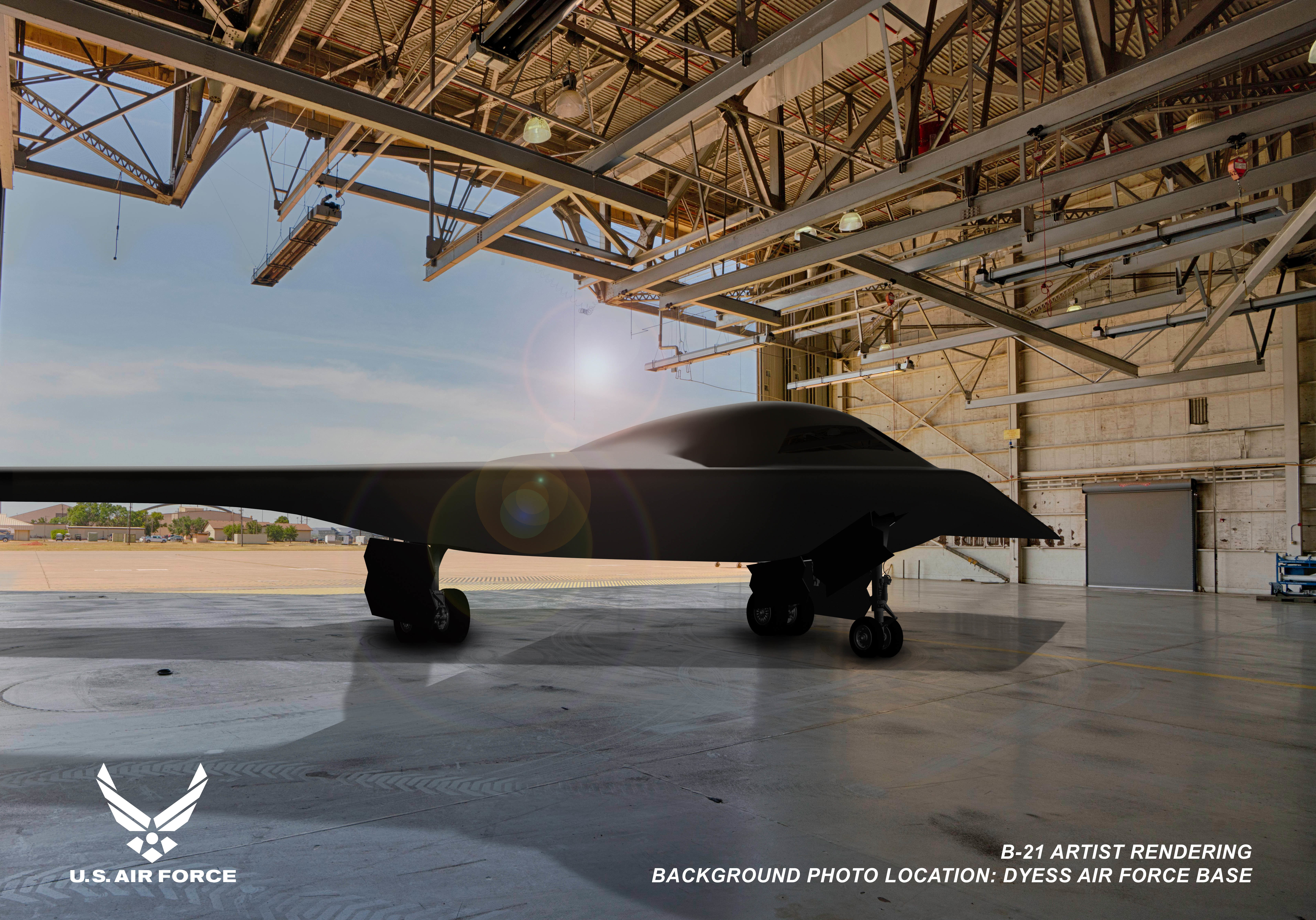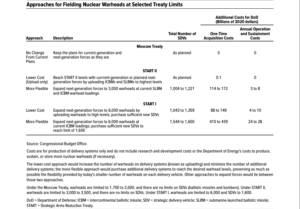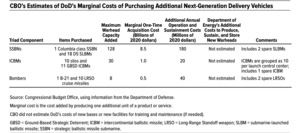
B-21 Raider
WASHINGTON: The demise of the New START treaty that limits US and Russian nuclear forces could wind up costing the United States as much as $439 billion in modernization costs, plus another $28 billion annually for maintenance of a souped-up nuclear arsenal, finds a new study by the Congressional Budget Office (CBO).
Or, it could cost almost nothing at all, says the CBO report, mandated by Democrats on the Senate and House Armed Services Committees.
“DoD’s one-time costs could range widely, from zero if the United States chooses not to make any changes to its current plans, to about $100 million to $172 billion if it expanded its (nuclear) forces to START II levels, to $88 billion to $439 billion if it expanded to START I levels,” CBO’s press release about the study, “The Potential Costs of Expanding U.S. Strategic Nuclear Forces If the New START Treaty Expires,” says.
The estimates only cover costs to DoD for weapons platforms that deliver nukes (called Strategic Delivery Vehicles or SDVs), however. They don’t include development and manufacture costs of any new nuclear warheads, which are built and maintained by the Energy Department. But the study’s cost estimates for each scenario involving a build-up of the arsenal represent new costs — I.e. extra costs beyond currently planned spending for DoD on its on-going nuclear modernization effort. (CBO in January estimated the modernization effort will cost a total of $234 billion over the next 30 years.)
“The report shows that the already excessive and unsustainable financial costs to maintain and modernize the U.S. nuclear arsenal could soar even higher if the treaty expires in five months with nothing to replace it and the United States choses to increase the size of the arsenal,” Kingston Reif, director of disarmament and threat reduction policy at the Arms Control Association, told Breaking D in an email today.
The problem with calculating funding requirements is simply that there is no way to judge what a future president might decide about how many and what types of nuclear weapons platforms are needed because we won’t know as much about the size of the Russian arsenal once New START expires, the study explains.
That said, experts say that eventually the momentum toward a US nuclear build-up would become almost unstoppable. Indeed, the need for transparency into each other’s nuclear force structure to serve as a brake on a run-away arms race was the entire reason behind the US-Soviet arms control treaties in the first place.
“If the Russians start building up, our history suggests that our reaction will be to do the same. And in fact, if we thought the Russians were starting to build up — because of course we won’t know anymore because we can’t verify — then history would suggest that we would also build up. So I think there will be some real pressures to build up,” said one long-time arms control analyst.
“Ever-increasing spending on nuclear weapons without an arms control framework that bounds U.S. and Russian nuclear forces is a recipe for budget chaos, undermining strategic stability, and damaging the health of the global nonproliferation regime,” Reif said.
Because there is no way to predict the size of a future US nuclear arsenal — and just as importantly the mix of ICMBs, bomber and nuclear submarines making it up — CBO chose to price out cost ranges for arsenal sizes based on weapons caps included in three former US-Russian treaties: the 1991 Strategic Arms Reduction Treaty (START) I; the 1993 START II; and the 2002 Strategic Offensive Reductions Treaty (SORT, but more commonly called the Moscow Treaty).
“The lower end of each of those ranges reflects a lower-cost, less-flexible approach that emphasizes loading more warheads on each missile and buying fewer new systems; the upper end reflects a more-flexible, higher cost approach that emphasizes keeping warhead loadings on missiles similar to what the United States deploys today,” CBO’s release explains.
The study does note that expanding the nuclear arsenal could take many years. “Available warheads could be uploaded relatively quickly, but additional delivery systems and warheads would probably not be available before the late 2030s or early 2040s. Most of the additional costs of expanding forces would thus occur a few decades from now.”
The study found:
- Expanding forces to Moscow Treaty limits (1,700 to 2,200 warheads) would not increase the Department of Defense’s (DoD’s) costs relative to its current plans, which call for fielding a new generation of strategic nuclear delivery vehicles to replace the current generation. CBO estimates that DoD’s production costs (not including development or operation costs) for implementing its current plans would total $240 billion over the next few decades.
- Expanding forces to START II limits (3,000 to 3,500 warheads) or to START I limits (6,000 warheads) could be accomplished by increasing the number of warheads on each missile (which CBO refers to as the lower-cost approach) or by increasing the number of delivery vehicles (missiles, submarines, and bombers), which CBO refers to as the more flexible approach, or by some combination of the two.
- Increasing warhead loadings to reach the START II limits would incur about $100 million in onetime costs for DoD. Increasing the number of delivery vehicles while maintaining current warhead loadings would increase DoD’s onetime costs by up to $172 billion over several decades and annual operating costs by $3 billion to $8 billion. (All costs are in fiscal year 2020 dollars.)
- If DoD expanded forces to START I limits using the lower-cost approach, its onetime costs would rise by $88 billion to $149 billion and its annual costs by $4 billion to $10 billion. Under the more flexible approach, DoD’s onetime costs could increase by $410 billion to $439 billion and its annual costs by $24 billion to $28 billion. Total production costs would be nearly triple what DoD is currently planning to spend on production over the next few decades.
In addition, to aid future analysts as decisions are made about purchasing new platforms, CBO provided estimates for buying additional delivery platforms equipped for carrying their maximum number of warheads (i.e., one additional SSBN ballistic missile submarine, one B-21 bomber, and 10 new Ground-Based Strategic Deterrent (GBSD) silos.) For example, the study finds that 1 B-21 with 10 Long-Range Stand-Off (LRSO) cruise missiles and capable of launching eight nuclear warheads would cost $500 million, and $40 million a year (in 2020 dollars) to maintain.
New START, currently the only remaining US-Russia treaty capping nuclear weapons arsenals, will expire in 2021. The treaty limits Russia and the US each to no more than 1,550 deployed strategic warheads and 700 deployed strategic delivery vehicles (meaning ICBMs, submarines and bombers).
As Breaking D readers know, the Trump Administration has been publicly waffling on whether it will pursue a five-year treaty extension to avoid New START’s demise. Instead, President Donald Trump has ordered his staff to begin work on a possible new trilateral nuclear arms control treaty that he hopes include China and cover sub-strategic weapons (of which the Russians have more than the US) that are not covered by New START. Such a multilateral treaty is widely considered pie-in-the-sky by nuclear arms control experts.
Indeed, in a press briefing June 24 following a meeting with Russian counterparts in Vienna, Trump’s top arms control envoy Marshall Billingslea laid out conditions for any US agreement to extend New START that arms control experts say simply cannot be met. (Billingslea, a protégé of former National Security Advisor John Bolton, is, like his mentor, famous for his distaste for nuclear arms control.) These conditions include: China joining the treaty; expanding coverage to non-strategic weapons; and new verification clauses.
“Russian officials have reiterated their readiness to extend New START now. Amb. Billingslea’s conditions will thwart extension for the foreseeable future. That’s unfortunate. By not extending New START, the Trump administration forgoes a simple action that would strengthen U.S. national security and make Americans safer,” wrote Steven Pifer, a former State Department Russia hand and arms control negotiator now an affiliate at Stanford University’s Center for International Security and Cooperation (CISAC), on CISAC’s website June 30.
Air Force picks Anduril, General Atomics for next round of CCA work
The two vendors emerged successful from an original pool of five and are expected to carry their drone designs through a prototyping phase that will build and test aircraft.


























